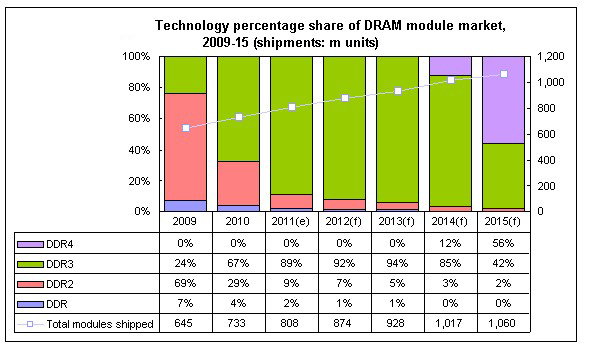With market share averaging in the stratospheric 85% to 90% range, DDR3 modules will remain the dominant technology in the DRAM market for 2011 and at least three more years before it cedes ground to a faster, next-generation versionuppli.
DDR3 in 2011 is projected to account for 89% of the 808 million DRAM module units shipped this year, up from 67% in 2010 and 24% in 2009. In comparison, the older and slower DDR2 will make up 9% of the module market in 2011, down from 29% last year. The legacy-type product of DDR will take up the remaining module shipments in the market.
DDR3 will see its share of DRAM module shipments actually rise during the next two years - to 92% in 2012 and to 94% the year after - before it heads down an irreversible cycle of decline that starts in 2014. DDR4, whose standards are in the process of being finalized, is expected to make its first substantial presence in the market in 2014 immediately garnering about 12% share. By 2015, the tables will have turned with DDR4 modules taking a majority share of market at 56%, compared to 42% for DDR3, out of total DRAM module shipments of approximately 1.1 billion units.
"DDR3 has been the main DRAM module technology shipped in terms of bits since the first quarter of 2010, gaining adoption quickly in the PC ecosphere as the market's primary driver," said Clifford Leimbach. "Not only is DDR3 the dominant technology today in the three PC channels for original equipment manufacturers, the PC white-box space and the upgrade market, DDR3 is also the chief presence across all PC applications, such as desktops and laptops, as well as their subcategories in the performance, mainstream and entry-level computing sectors."
While erstwhile leader DDR2 remained at the pinnacle of the DRAM module market for approximately four years, DDR3 will enjoy a run at the top for a total of five, starting from 2010 until its projected end as the dominant force by 2014. By then, the main densities of DRAM modules also will have shifted from 1-gigabyte (1GB) in 2009 to 8GB in 2015.
With DRAM technology stabilizing for the time being, a new module form factor appears ready to make an initial foray into the higher-performance world of server computers. Load-reduced DIMM (LRDIMM), mainly in the form of higher densities at 16GB and up, are set to vastly increase the memory capabilities of high-capacity computing workhorses such as enterprise servers and mainframe computers. Not compatible with older systems, LRDIMMs will only begin shipping as new computer systems are procured, appearing in the second quarter.

|